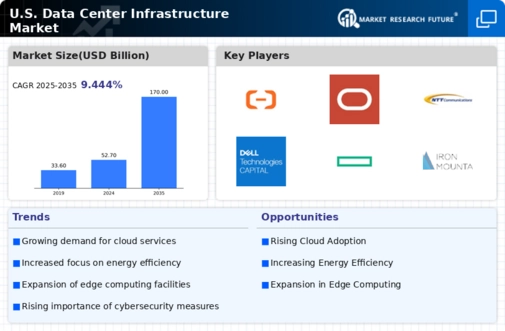Growth of Big Data Analytics
The proliferation of big data analytics is a significant driver for the data center-infrastructure market. As organizations increasingly rely on data-driven decision-making, the volume of data generated and processed continues to rise exponentially. In 2025, it is estimated that the big data analytics market will reach $274 billion in the US, necessitating robust data center infrastructure to support the storage and processing of vast amounts of data. This trend compels organizations to invest in scalable and flexible infrastructure solutions that can accommodate fluctuating data workloads. Consequently, the data center-infrastructure market is poised for growth as businesses seek to enhance their analytical capabilities and derive actionable insights from their data.
Increased Focus on Data Security
As cyber threats become more sophisticated, the emphasis on data security is a significant driver for the data center-infrastructure market. Organizations are increasingly investing in advanced security measures to protect sensitive information stored in data centers. In 2025, it is projected that spending on cybersecurity solutions will reach $200 billion in the US, reflecting a growing awareness of the importance of safeguarding data. This trend compels data center operators to enhance their infrastructure with state-of-the-art security technologies, such as firewalls, intrusion detection systems, and encryption solutions. The integration of these security measures not only protects data but also builds trust with clients, further stimulating demand for secure data center infrastructure.
Rising Demand for Cloud Services
The increasing reliance on cloud computing is a primary driver for the data center-infrastructure market. As businesses transition to cloud-based solutions, the need for robust data center infrastructure intensifies. In 2025, it is estimated that cloud services will account for approximately 60% of total IT spending in the US. This shift necessitates the expansion and enhancement of data center facilities to accommodate the growing volume of data and applications hosted in the cloud. Consequently, investments in infrastructure, including servers, storage, and networking equipment, are expected to surge, thereby propelling the data center-infrastructure market forward. Furthermore, the demand for hybrid cloud solutions is likely to drive innovation in infrastructure design, ensuring that data centers can efficiently support diverse workloads.
Regulatory Compliance Requirements
The evolving landscape of regulatory compliance is a crucial driver for the data center-infrastructure market. Organizations are mandated to adhere to various regulations concerning data privacy and protection, such as the CCPA and HIPAA in the US. Compliance with these regulations often necessitates significant investments in data center infrastructure to ensure that data is stored, processed, and transmitted securely. In 2025, it is anticipated that compliance-related expenditures will account for approximately 15% of total IT budgets in the US. This trend underscores the need for data centers to implement robust infrastructure solutions that facilitate compliance, thereby driving growth in the data center-infrastructure market.
Technological Advancements in Infrastructure
Technological innovations are continuously reshaping the data center-infrastructure market. The advent of advanced technologies, such as 5G, IoT, and AI, is driving the need for more sophisticated data center solutions. In 2025, the market for AI-driven data center management tools is expected to grow by 25%, indicating a shift towards automation and efficiency. These advancements enable data centers to optimize resource utilization, reduce operational costs, and enhance performance. As organizations seek to leverage these technologies, the demand for cutting-edge infrastructure that can support high-performance computing and low-latency applications is likely to increase, further propelling the data center-infrastructure market.
























Leave a Comment